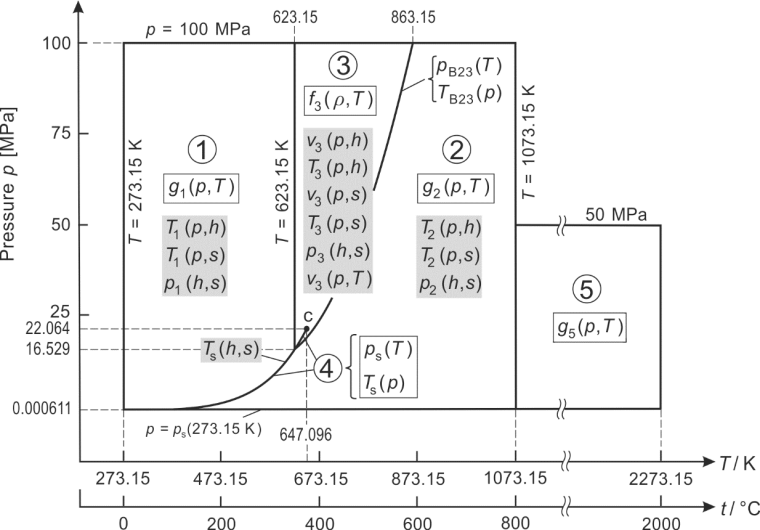In 1997, the International Association for the Properties of Water and Steam (IAPWS) adopted the industry standard "IAPWS Industrial Formulation for the Thermodynamic Properties of Water and Steam”, IAPWS-IF97 for short. IAPWS-IF97 replaced the IFC-67 industry standard that had been valid until 1967. Details on the software for the Industrial Formulation IAPWS-IF97 for Water and Steam can be found here.
The IAPWS Industrial Formulation IAPWS-IF97 consists of a set of equations for different regions and covers the following overall range of validity:
0 °C ≤ t ≤ 800 °C, p ≤ 1000 bar (100 MPa)
800 °C < t ≤ 2000 °C, p ≤ 500 bar (50 MPa)

Structure and regions of IAPWS-IF97.
The figure above shows the five regions into which the entire range of validity of the IAPWS-IF97 is divided. The boundaries between these ranges can be seen directly in the figure with the exception of the boundary between regions 2 and 3. This boundary, which corresponds approximately to the isentropic line s = 5.047 kJ kg–1 K–1, is defined by an appropriate auxiliary equation. Regions 1 and 2 are both individually covered by a fundamental equation for the specific Gibbs free energy g(p,T), region 3 by a fundamental equation for the specific Helmholtz free energy f(ρ,T), and the saturation curve, corresponding to region 4, by a saturation-pressure equation ps(T). The high-temperature region 5 is also covered by a g(p,T) equation. These five equations, shown in rectangular boxes in the figure, form the so-called basic equations.
To achieve high accuracy of this industry standard, IAPWS-97 was coupled to the scientific standard for calculating the thermodynamic properties of water, the IAPWS-95 formulation (see here). This coupling was achieved by fitting the basic equations of IAPWS-IF97 for regions 1 to 3 and 5 to the values calculated from IAPWS-95 for the following state variables: specific volume v, specific enthalpy h, specific isobaric heat capacity cp, speed of sound w and saturation pressure ps.
Based on the "bank of terms" specially formulated for the basic equations of ranges 1 to 3 and 5 of IAPWS-IF97, the final equations were obtained using our structure optimization procedure [1].
In addition to these basic equations, so-called backward equations are provided for regions 1 to 4. These backward equations were developed in the following combinations of variables: For regions 1 and 2 as equations of the form T(p,h), T(p,s), and p(h,s), for region 3 as equations of the form T(p,h), v(p,h), T(p,s), v(p,s), p(h,s) and v(p,T). The backward equation for the entire region 4 is a saturation-temperature equation Ts(p), which is mathematically completely consistent with the saturation-pressure equation ps(T). For the technically most important part of region 4 (s ≥ s''(623.15 K)), there is a saturation-temperature equation of the form Ts(h,s). In the figure above, in addition to the (framed) basic equations, all of these types of backward equations (marked in grey) are assigned to the corresponding region of IAPWS-IF97.
The backward equations are extremely consistent with the respective basic equation. In this way, all properties for regions 1 to 3 can be calculated as a function of the input variables (p,h), (p,s) and (h,s), as well as for the entire range 4 as functions of (p) and for the technically most important part of range 4 (s ≥ s'' (623.15 K)) as a function of (h,s) without any iteration. Using the backward equations v(p,T) for range 3, the specific volume (and thus all other properties) can be calculated from the basic equation f(ρ,T) without iteration. Due to this special concept for the industry standard IAPWS-IF97, all important combinations of state variables can be calculated without the need for iterations and thus extremely fast.
A complete description of the individual equations of IAPWS-IF97 is given in the book of Kretzschmar and Wagner [2]. It contains comprehensive steam tables, three overview diagrams (Mollier h-s diagram, T-s diagram, log(p)-h diagram) and pressure-temperature diagrams with isolines of more than 25 properties. Equations for transport properties as well as for the properties surface tension, dielectric constant and refractive index are also given. Further details (table of contents, sample pages, etc.) can be found here.
The international publication on IAPWS-IF97 by Wagner et al. [3] gives details on requirements, concept, accuracy, consistency at region boundaries.
Software for IAPWS-IF97
Based on the IAPWS-IF97 including all backward equations as well as the equations for the transport quantities also included in the above mentioned book, corresponding software for the calculation of more than 25 state variables (including transport quantities) is available.
For details on the software for the IAPWS-IF97 see here.
References
[1] Setzmann, U., Wagner, W. A new method for optimizing the structure of thermodynamic correlation equations. Int. J. Thermophysics 10 (1989), 1103-1126. https://doi.org/10.1007/BF00500566
[2] Kretzschmar, H.-J., Wagner, W. International Steam Tables – Properties of Water and Steam based on the Industrial Formulation IAPWS-IF97. Springer-Verlag, Berlin, 2019. https://doi.org/10.1007/978-3-662-53219-5
[3] Wagner, W., Cooper, J. R., Dittmann, A., Kijima, J., Kretzschmar, H.-J., Kruse, A., Mareš, R., Oguchi, K., Sato, H., Stöcker, I., Šifner, O., Takaishi, Y., Tanishita, I., Trübenbach, J., and Willkommen, Th. The IAPWS Industrial Formulation 1997 for the Thermodynamic Properties of Water and Steam. Journal of Engineering for Gas Turbines and Power 122 (2000), 150-182. https://doi.org/10.1115/1.483186